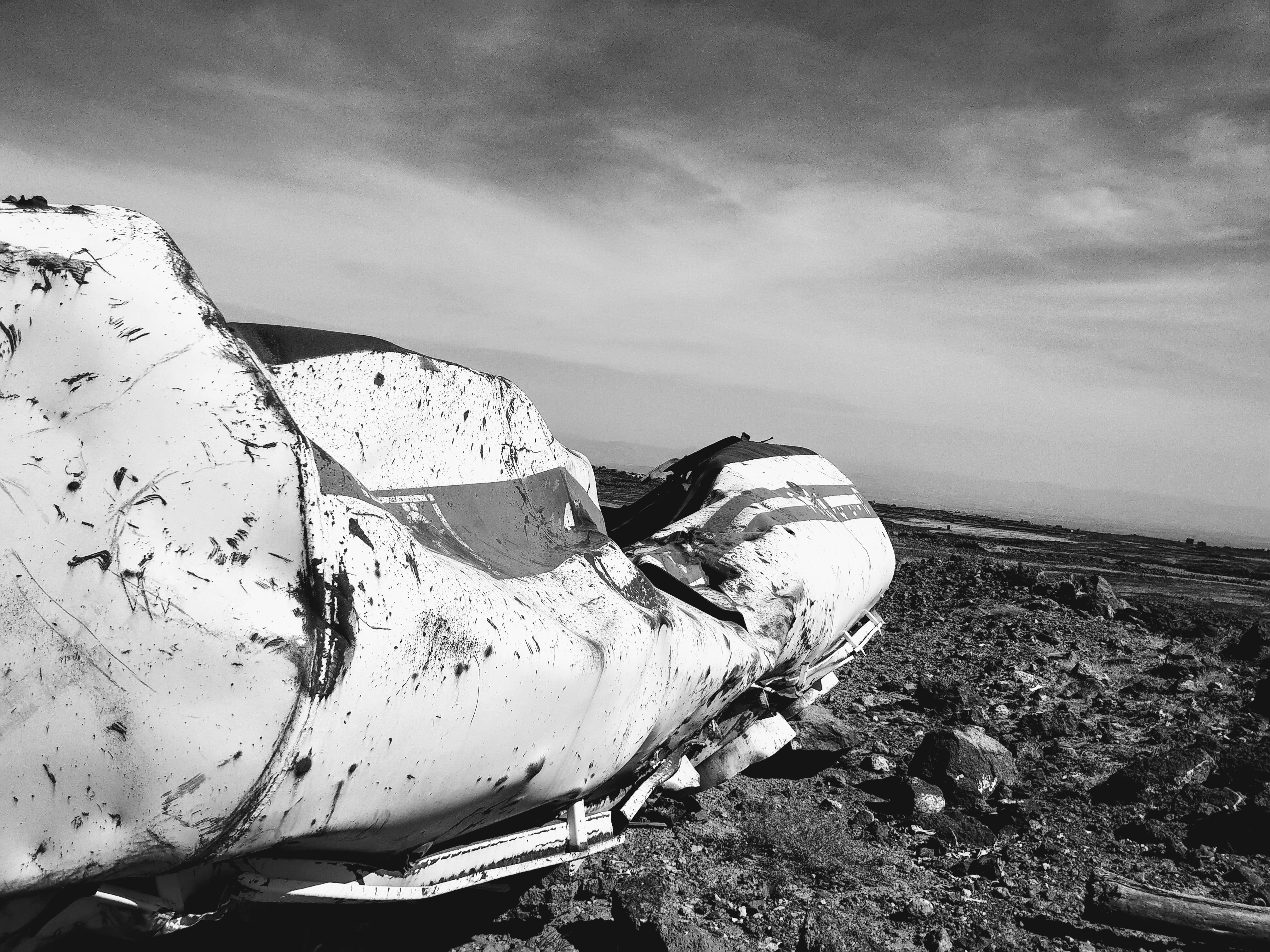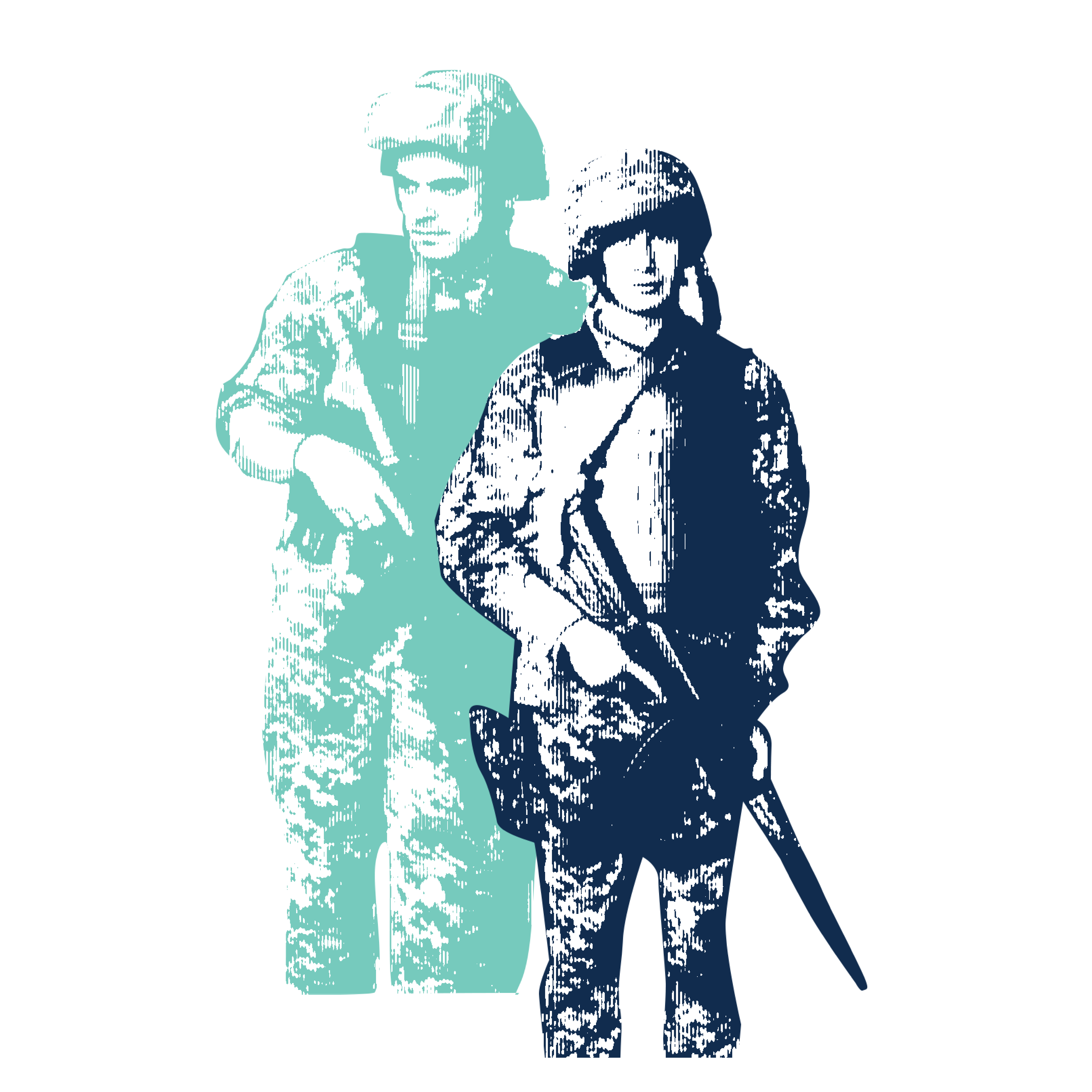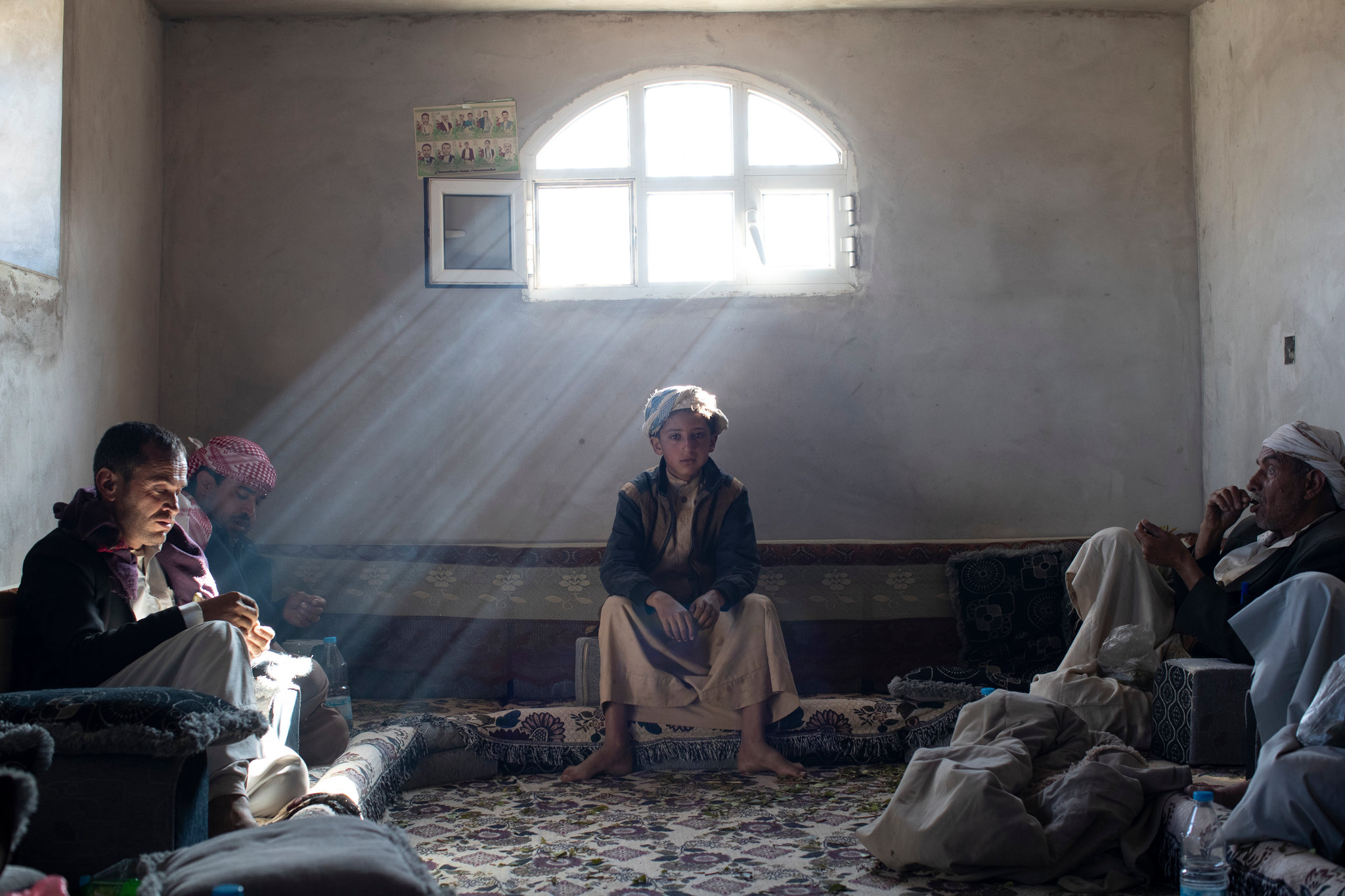
Just before midnight, a businessman named Rabee’a was on the phone, trying to calm his friend down. Rabee’a owned a drill rig, and his friend had heard stories from elsewhere in Yemen about jets bombing well sites. It was Sept. 10, 2016, a year and a half into the war between the Saudis and the Houthi rebels. But to Rabee’a, it was a war happening over the horizon, out of sight. He was unbothered. That kind of thing wouldn’t happen in a poor place like this one, a district called Arhab that, though deep in rebel territory, was home to nothing and no one of interest to a fighter jet.
Besides, things like airstrikes didn’t happen to people like him. Rabee’a was a charitable man from a privileged family — a little self-satisfied, perhaps, but he had enjoyed good fortune for much of his life, and that wasn’t about to change. Despite a mischievous grin, he was a godly man, a good man, and finding water in poor places for poor people had become his calling; he even forgave debts when his customers couldn’t pay. His big heart, he was certain, had locked in his good luck. “I’m doing a good, legitimate business!” he said. “Those jets have no quarrel with a man on the road to God!”
He hung up. It was a peaceful night. There was electricity in the air. Behind him, people were celebrating, and they were celebrating him, really.
Arhab had been running low on water. Villagers didn’t have enough to drink or to irrigate new fields. They needed a well, but no government entity was capable of undertaking such a public-works project; no bank was available to extend a line of credit. None of the villagers in the district, most of whom farmed plots five or 10 meters square, had anywhere near the kind of capital it would take to finance the dig.
So people from villages around the district found their own solution, working out a kind of shared-ownership arrangement. They all would benefit together if the drill struck water; each shareholder would get a few hours at the well every week. If the digging didn’t succeed, though, they would all lose money they couldn’t afford to lose. And there was no guarantee of success: The land was hard, and the best location for the well was high up on the black volcanic rock. Rabee’a arrived excited for the chance to be the one who found water in a hard place.
He had started six weeks earlier. After 12 days, the machine broke. Rabee’a and his workers managed to fix the drill and get it through 400 meters before layers of earth began collapsing, pinning the drill in place. For a day, he made no progress. Then two more days, then a week, as the villagers’ tab continued to run. After two weeks, with costs rising, Rabee’a got the drill free and guided it down through a few hundred more meters until water bubbled forth with the waste sand.
News spread; people cheered. The gamble had paid off. Some villagers made their way up to the site, to bring Rabee’a food and to celebrate their new well. Eid was the next day, so it felt a little like a miracle. For Yousef, one of the drill workers, striking water meant he would go home for the holidays flush with cash. He went about his work, moving between the rig and a big tanker truck full of water to cool the drill. He took a break in the back of one of the trucks.
'I’m doing a good, legitimate business! Those jets have no quarrel with a man on the road to God!'
Rabee’a’s cousin arrived, a young judge whose name was Judge — Al-Qadi — a usually studious man who needed something to celebrate. He had worked at a court in Amran until the compound was bombed. He got a job in the capital, Sana, at the traffic court, but with the Saudis blockading the country, there wasn’t as much fuel, which meant less driving and fewer cases. He didn’t have anything else to do, so he decided to come to Arhab. Mahdi arrived, too, a pale old man chosen as a representative of the shareholders. Once he heard Rabee’a hit water, he set out for the well site, carrying all the villagers’ money to pay the next installment.
Fahd also showed up, the closest thing the villagers had to a lush. Just about every man in Yemen chews khat, a mild narcotic leaf, but they don’t all chew it the way Fahd did. He chewed it both sides at a time, two big, puffed-out Louis Armstrong cheeks, whenever villagers gathered. Tonight he was even more energetic than usual, thanks to his acute sense of relief. Though he couldn’t really afford to invest in the well project, he had felt compelled to buy a share; he felt that the village needed him. He spent a month visiting friends and relatives, charming and cajoling them into giving him loans; when he still didn’t have enough, he asked his wife if he could sell her gold jewelry. Rabee’a’s striking water had spared Fahd and his family from financial ruin.
Fahd felt a little cold, though, so he walked away from the drill toward an old stone hut where some friends had gathered. At about that moment, thousands of feet above him, a pilot pushed a button that sent an electrical signal to a rack mounted underneath his plane. A series of pyrotechnic cartridges flashed, and a set of hooks holding a bomb in place popped open, while small pistons shoved the weapon away.
Now, as Fahd walked into the hut, a weapon about the length of a compact car was wobbling gracelessly down through the air toward him, losing altitude and unspooling an arming wire that connected it to the jet until, once it had extended a few feet, the wire ran out and ripped from the bomb.
Then it was as if the weapon woke up. A thermal battery was activated. Three fins on the rear extended all the way and locked in place. The bomb stabilized in the air. A guidance-control unit on the nose locked onto a laser reflection — invisible to the naked eye but meaningful to the bomb — sparkling on the rocks Fahd walked over.
Fahd was in a buoyant mood as the weapon homed in on a point just a few meters from him, a few meters from the drill, from Rabee’a, from the judge whose name was Judge, from the drill worker lying down for a rest, from the old man arriving with the installment of cash the villagers owed.
Above them, the warhead closed in at a few hundred knots.
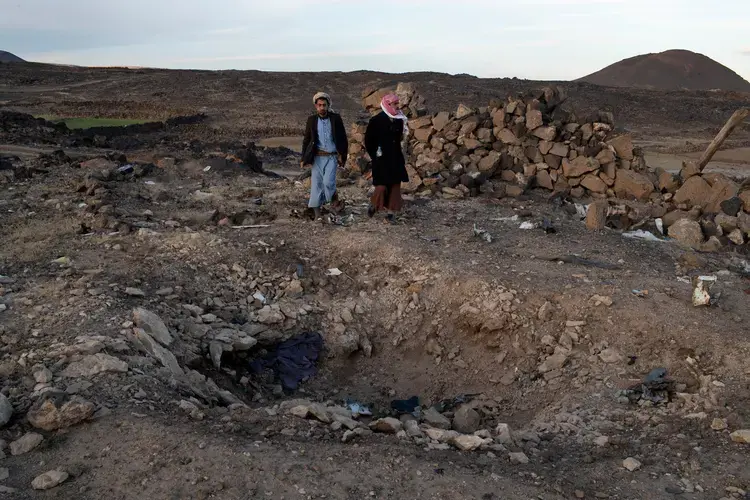
The war in Yemen has been going on for three years now. It began when the Houthis — a rebel group whose members mostly belong to the Zaydi sect of Shia Islam, a minority of a minority — took Yemen’s capital in September 2014 and, with it, control over much of the country. Saudi Arabia, the Sunni superpower of the region, feared that this ascendant Shia movement to its south was a proxy of Iran, its chief rival. Concerned about encirclement by Shia forces, Saudi Arabia started bombing Yemen in March 2015, soon after the Houthis established a government.
Almost immediately, the United Nations and human rights groups expressed alarm about the way the war was being prosecuted, with its startling toll on civilians and critical infrastructure. The Saudis’ bombs have struck factories, roads, bridges, hospitals, wells, funerals, weddings, gatherings entirely of women and a school bus full of children. The United Nations reported last month that it has documented about 18,000 civilian deaths and injuries that have resulted from the fighting, almost 11,000 of them from airstrikes alone. Several other groups believe these estimates to be conservative.
The Saudis have also blockaded Yemen, with the stated purpose of keeping weapons out of Houthi hands, but that has also made it extremely difficult to get food and humanitarian assistance into an already poor country. Together, the bombing campaign and blockade have spurred the worst continuing humanitarian crisis in the world. Eight million people are on the brink of famine; according to Save the Children, an international aid organization, 85,000 Yemenis under age 5 have already died of starvation. A cholera outbreak has spread to 21 of Yemen’s 22 provinces.
In carrying out the campaign in Yemen, the Saudis have been drawing on help from other Persian Gulf states, like the United Arab Emirates, Bahrain and Kuwait, as well as nearby African countries, like Sudan and Egypt. But its most important source of material support is one faraway ally: America. In 2015, the United States sent an aircraft carrier, a guided-missile cruiser and seven other warships to help the Saudis enforce the blockade. As the Saudis began running sorties into Yemen, United States Central Command began flying American Stratotankers on refueling missions every day, until last month, allowing Saudi jets to loiter in the sky for longer in search of targets, rather than having to plan strikes in advance. Perhaps most crucial, America has sold the Saudis billions of dollars’ worth of high-tech weapons to help them counter Iranian influence to their south.
It wasn’t so long ago that Iran was the prime beneficiary of the American arms trade. According to William Hartung, the director of the Arms and Security Project at the Center for International Policy, Iran was a favored customer of Presidents Richard M. Nixon, Gerald Ford and Jimmy Carter, back when it was considered a stalwart of modernization and order in the Middle East. But after the revolution in 1979 that put the ayatollah in power, Saudi Arabia came to look like a model of stability in the region. And soon the Sunni kingdom became one of the most reliable patrons of the American defense industry.
By the time of the Clinton administration, the United States was the world’s biggest exporter of arms, with billions of dollars in weapons going to Saudi Arabia alone every year. Each successive president had new hopes for what propping up the Saudi military with weapons sales might accomplish. In 2007, President George W. Bush announced a $20 billion sale to the Saudis, in part to rebalance the region after the 2003 invasion of Iraq, which had deposed a Sunni government and allowed a Shia one to replace it. Bush had inadvertently empowered Iran, and he thought selling weapons to Saudi Arabia could counteract that. In 2010, President Barack Obama announced a package of deals worth $60 billion to provide advanced fighter jets and other arms to the Saudis, citing both Iranian influence and American job creation.
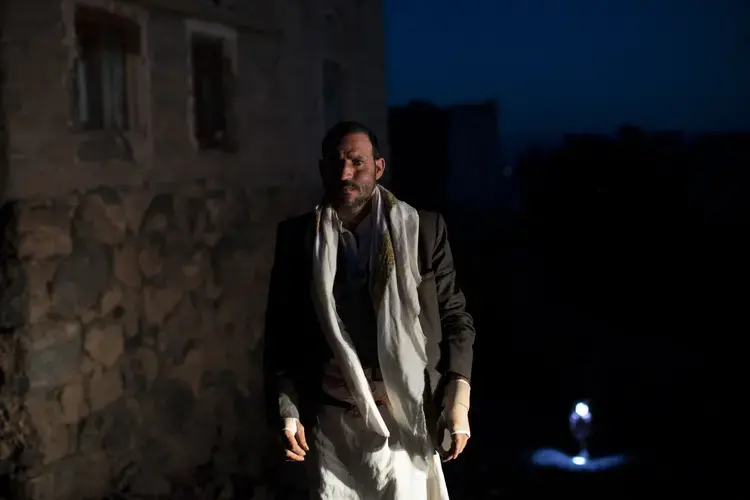
And then, in 2015, just as the Obama administration’s signature foreign-policy goal — a nuclear deal with Iran — came within view, and just as gulf countries got anxious that the deal might signal that the United States was distancing itself from them, the Houthis moved on the Yemeni capital, and a new country fell under Iranian influence. Saudi Arabia needed more American bombs to drop, and within a month of the nuclear deal’s adoption, the Defense Department announced an approved sale of $1.29 billion in mostly precision-guided bombs to Saudi Arabia. A year later, it was clear to the Obama administration that the Saudis were not using the guided weapons to minimize civilian casualties. So just before leaving office, Obama suspended the transfer of smart bombs to the Saudis.
President Trump immediately reversed the suspension. On his first foreign trip as president — to Saudi Arabia — he announced that he would resume and expand the sale of weapons. There was an effort in Congress to stop the process. Senator Rand Paul — a Kentucky Republican, who co-sponsored a bill to halt the sale of weapons to the Saudis with Senator Chris Murphy, a Connecticut Democrat — took to the Senate floor with a picture of a starving Yemeni child. “It is astounding what is going on there,” Paul said, “and it is being done without your permission, but with your weapons.” The resolution was defeated 53 to 47, mostly along party lines, a vast majority of Republicans siding against Paul and with the president.
Congress is again debating American involvement in the war in Yemen, but regardless of what happens in the future, the United States has already provided formidable capacity to the Saudi-led aerial campaign. From just 2010 to last year, according to the Stockholm International Peace Research Institute’s Arms Transfer Database, the United States delivered to Saudi Arabia 30 F-15 multirole jet fighters in the F-15SA-configuration — the most advanced iteration the United States produces — as well as 84 combat helicopters, 110 air-to-surface cruise missiles and nearly 20,000 guided bombs. This last category includes 11,320 Paveways: a type of laser-guided bomb that can be dropped from nine miles away and 40,000 feet up and that will, more often than not, strike within 10 feet of its target.
At the well site, at the moment of impact, a series of events happened almost instantaneously. The nose of the weapon hit rock, tripping a fuse in its tail section that detonated the equivalent of 200 pounds of TNT. When a bomb like this explodes, the shell fractures into several thousand pieces, becoming a jigsaw puzzle of steel shards flying through the air at up to eight times the speed of sound. Steel moving that fast doesn’t just kill people; it rearranges them. It removes appendages from torsos; it disassembles bodies and redistributes their parts. A sphere of expanding gas coming off the bomb, meanwhile, fills a body’s hollow parts with energy, rupturing eardrums, collapsing lungs, perforating abdominal cavities and making hidden things bleed. The blast wave pushes air to such extraordinary speeds that the wind alone can cast limbs off bodies.
The back of the tanker truck launched off its chassis and slammed into rock. Jagged pieces of bomb flew thousands of miles per hour outward, and Rabee’a — still celebrating his success — was almost fully decapitated. The top half of his face was removed, leaving just an open lower jaw; the heat of the blast burned most of his clothes off and charred his skin, so he was left naked, his genitals exposed, his body actually smoking. Next to him, his cousin Al-Qadi, the judge, was burning alive, his blood vessels expelling water and his body inflating. He began to scream.
Fahd had just stepped into the stone shelter and registered only a sudden brightness. He heard nothing. He was picked up, pierced with shrapnel, spun around and then slammed into the back wall, both of his arms shattering — the explosion so forceful that it excised seconds from his memory. Metal had bit into leg, trunk, jaw, eye; one piece entered his back and exited his chest, leaving a hole that air and liquid began to fill, collapsing his lungs. By the time he woke up, crumpled against stone, he was suffocating. Somehow he had survived, but he was killing himself with every breath, and he was bleeding badly. But he wasn’t even aware of any of these things, because his brain had been taken over by pain that seemed to come from another world.
He couldn’t think of anything except that he had to get out of the hut. As the dust began to clear, he saw that the ground was littered with burning chunks of metal. The hut had been turned into an oven, and he was trapped inside it. He felt as if he were in hell, as if it were Judgment Day. He had to get away, but when he tried to crawl over the burning metal, he fell down to his side because his forearms were pulverized. He began to roll, like a child going down a hill. He rolled over superheated metal, over the body parts of his friends. He wasn’t thinking about his friends. He wasn’t thinking about anyone. He wasn’t even thinking about his family. In that moment, Fahd forgot he had children.
Yousef woke up on top of the drilling truck’s cab, with the vague sense that he had been carried there by a wave of fire. He looked down and saw that his left leg had been ribboned into strings of blood and bone. He realized he was shaking. He groped around the debris littering the truck cab, trying to find something to tie off his leg; he knew, maybe from movies, maybe from friends, he didn’t know exactly how, that this is what you were supposed to do when a limb was ripped off. He saw a burst of bright flashes in the air — tracer rounds, a tribal S.O.S. — and knew someone was calling for help.
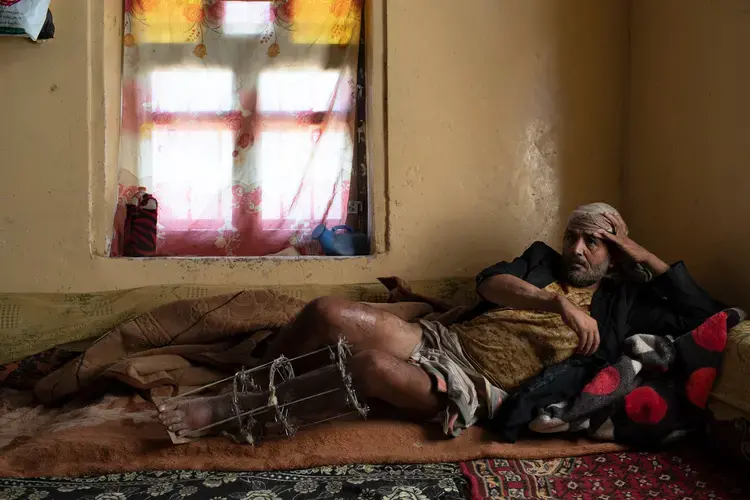
When Dr. Abdullatif Abotaleb, the director of Al Thawra Modern General Hospital in Sana, got a call about the airstrike in Arhab, he was at home in the capital, an hour and a half away. A small man with a tired, raspy voice that flips up an octave when he is exasperated, Abotaleb is a dynamo of energy — and he has to be, now that he has become perhaps the city’s busiest trauma surgeon in addition to running the entire 850-bed facility. On a day without airstrikes, just to make it from one side of his office to another, he has to push through the orbit of people shoving papers in his face; the hospital, with its singular appetite for signatures, often seems purposefully designed to maximize the amount of paper changing hands. It sometimes seems to Abotaleb as if every single employee there needs his personal attention.
When bombs fall, though, he escapes the paperwork. He goes down to the operating room and works nonstop, one patient after another, sometimes not emerging from surgery for 24 hours. And he has seen, in those hours standing over the operating table after airstrikes, grim things.
He has seen his own son. Just 20 years old, he was brought to the hospital blackened almost beyond recognition, after the car he was in was hit by an airstrike. Abotaleb found some grace in the severity of the burns — as he operated, he was able to imagine that the young man wasn’t his son. The illusion fell apart when he saw a scar he recognized on the patient’s big toe. Abotaleb couldn’t save him. He operated on his own brother, hit in a different strike, one that killed his other brother and his father, too. So now Abotaleb tries to banish feeling when he’s at work. He thinks of it as making his heart like stone. And when he’s done, he goes home and cries with his surviving children.
That morning in September 2016, when he arrived at the emergency department, he found the corridors lined with dying patients and desperate family members from a different airstrike, one that happened closer by in Sana. People yelled for him as he walked by, trying to hold his attention. Abotaleb tries to resist these appeals. He tries instead to focus on the patients he has a chance of saving. He does not count on miracles; even miracles require equipment, and because of the American-backed blockade, he was running low on pretty much every critical resource and diagnostic tool that a normal hospital needs to function, let alone one that sees regular mass-casualty events from bombs designed to dismember people hundreds of yards in every direction.
They were nearly out of general anesthesia. Lately, they had been relying on halothane, a cheap anesthetic suspected of causing liver damage, no longer used in North America. They weren’t able to get enough gloves or masks. They barely had any blood, because they couldn’t get the bags that hold donated blood past the blockade. They were even low on bedsheets, which they could change only once a week. And they couldn’t get the correct parts to properly fix the washing machine, so it broke nearly every day. Everything was dirty. The hospital was a septicemia factory; Abotaleb often worried that he was desperately trying to save patients just so they might survive long enough to die of an infection caught at his hospital.
But since the blockade began, Abotaleb had taught himself tricks. He used IV lines to join severed arteries; he used IV lines as feeding tubes. He is up against bombs so proficient at traumatic amputations that his burn patients often don’t have other limbs to graft from, so he has learned to be creative when finding places on of the body to harvest skin. And he has learned not to try to help patients he doesn’t think he can save.
That morning, he saw a boy he should have walked past but didn’t. Three years old, maybe younger, certainly no older. The boy’s legs were gone; part of an arm was, too. As Abotaleb worked in vain on the boy in the operating room, victims from Arhab began arriving outside, piled together in the back of a pickup truck. Al-Qadi was almost unrecognizable from the swelling. A slight man, he now looked obese. Yousef the drill worker looked possessed, his eyes vacant and, somehow, at the same time wrathful. Fahd was suffocating and bleeding out, five minutes from death, maybe less.
Abotaleb knew immediately that Fahd needed equipment he didn’t have, but Abotaleb chose him anyway. The bleeding and the fractures and the shrapnel were not Fahd’s only — or even most pressing — issues. One side of his chest was totally compressed, and he was almost unable to breathe. Abotaleb needed an underwater seal drainage system, a piece of equipment that creates closed suction, which allows air and fluid to escape the pleural cavity but none to come back in, relieving pressure on the chest and allowing the patient to breathe.
The hospital didn’t have one of those. So Abotaleb improvised. He asked someone to bring him a plastic water bottle. He cut a hole in one end and put an IV line into it. He cut into Fahd’s chest and bound the other end of the IV line into the space between his rib cage and his lungs. Fahd was in agony as Abotaleb cut into him. He also felt intense thirst; he had lost so much blood that he was in shock. To Fahd, it seemed as if the people hovering over him were there to continue his torture. He had an animal instinct to strike back. He couldn’t use his arms but wished Abotaleb would get close enough for him to bite.
Still, the doctor continued to work. With one end of the IV line inserted into Fahd’s chest and the other end attached to a hole in the plastic water bottle a few centimeters below the water line, the contraption created a one-way valve that let air and fluid out of Fahd’s chest while preventing any from going the other way. With the lines in place, Fahd’s chest began to empty. Fahd’s lung finally began to inflate.
Next, Abotaleb tried to stabilize Al-Qadi; he and his nurses bound as much of his skin as they could with the little gauze they could expend on him, but the director knew they needed to get him out of there. With his skin flaking off, Al-Qadi was losing his barrier to the outside world, and this hospital was the worst place for someone susceptible to infection. They sent him to another hospital, where he survived for two more days.
Abotaleb went to the next patient, who seemed to be bleeding internally, but it was unclear where, and he didn’t have access to imaging tools, so he did what he often did: He cut the patient open and looked around. He found the worst of it was the patient’s liver, so he began trying to stitch it with the wrong kind of needle, because the hospital didn’t have liver needles. He made the liver bleed more. He waited a few minutes for it to subside before trying to stitch again. But before he could finish, he got a call: Something else had happened at the well in Arhab. More patients were coming.
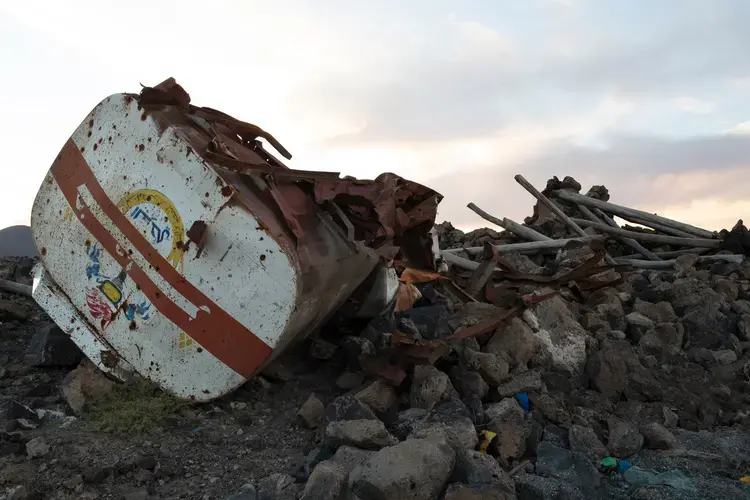
When the Saudis buy weapons, they prefer to use the Foreign Military Sales program (F.M.S.), meaning that the United States Department of Defense serves as their broker. For a 2 percent administrative fee tacked on to the purchase price, the Pentagon handles the logistics and liaises with the private companies to fulfill the order. F.M.S., the mission of which is to “strengthen the security of the U.S. and promote world peace,” is actually overseen by the State Department, which reviews all requests. More than 100 countries around the world bought weapons from the United States this way in the 2017 fiscal year. Certain countries can buy certain weapons systems directly from manufacturers, but the Saudis like the politics of buying from the United States government and feel they get more expeditious treatment from American companies when the Pentagon speaks on their behalf.
Normally, after a sale through F.M.S., the military’s transportation command takes possession of the weapons and delivers them to the foreign customer. But Saudi Arabia instead hires private charter flights — giant Soviet-era Ilyushin cargo planes, filled with guided-bomb components — and flies them all the way to Saudi Air Force bases. There, the tail fins and the laser-guidance kits are attached to either end of the warheads, and free-fall gravity bombs are transformed into laser-guided weapons, which are then loaded up onto the bomb racks beneath jet fighters. It’s a process that happens at the Saudi’s base in Dhahran on the Persian Gulf and at King Khalid Air Base in Saudi Arabia’s southwestern corner. King Khalid is the country’s southernmost base and has a squadron of F-15s strategically stationed there. It happened to be just 200 miles from a new well about to come online in a district called Arhab. An F-15 at top speed can close that distance in about six minutes.
That morning, villagers all around Arhab were making their way to the bomb site. Some came to try to help; some came searching for missing loved ones. Many of them, especially the children, came out of curiosity, running out of the house before parents could grab them, trying to find out what that rumble was that woke them in the middle of the night. A little after daybreak, more than a hundred people had gathered.
There is some disagreement about what happened next. Some say they heard multiple planes. Some heard others scream. Some swear that there was no warning, that they didn’t hear or see anything beforehand. What’s not in dispute is that the second wave of bombing began about six hours after the first explosion, once a sizable crowd had formed.
There was a sudden, massive upwelling of air and debris, and everybody started to run. People went in all different directions as the planes roared overhead and things started to explode. Cars and motorcycles went hurtling through the air. Boys were cut down as they tried to escape; grown men dove into nearby cornfields. The attack lasted for hours. It felt as if another bomb fell every few minutes — each of them seeming to strike people trying to escape, as if following them. The people said it did not feel like an attack. The word they used translates to “extermination.”
Human Rights Watch reported that at least 31 civilians were killed, three of them children, and that 42 more were injured. It’s hard to know the numbers for sure, because all that was left of many victims were very small parts, very far from one another. People dragged sheets around the bomb site, trying to collect parts they thought might belong to loved ones. Cellphones didn’t always survive explosions, but inside them, memory cards sometimes did, and sometimes those memory cards had photos that helped villagers identify the missing. At least 11 bodies were so charred or mutilated that they could not be identified. And most of the villagers were so traumatized, so terrified, that they didn’t want to go outside at all.
Islam compels its adherents to bury the deceased within 24 hours, so the villagers of Arhab had to hold funerals, but they were too afraid to gather outside. No one knew when planes might appear out of nowhere again. In homes all across Arhab, minor dramas played out as surviving family members argued with one another about who got to go say goodbye and who had to stay home. The funerals were poorly attended.
All across the country, people were learning a version of the same lesson. They stayed home from factory jobs, because even if their factory hadn’t been hit, maybe it would be next. On the roads, people kept extra car lengths when driving behind cargo trucks. Anything of value — anything bringing commerce or food or health — could, at any moment, explode and disassemble your friends.
It’s hard to say what the aggregate effect of living in constant terror of airstrikes has been. A local human rights worker pointed out one thing, though: She noticed that Yemenis had stopped digging wells. And maybe this is part of the reason the number of people in critical need of clean water rose. With sanitation facilities and wells like the one in Arhab coming under attack, cholera was, perhaps, inevitable. The first cases were reported three weeks after the strike in Arhab (and a few dozen miles away). Seven months later, the country had more than 100,000 suspected cases. Arhab had one of the highest attack rates in the country, and after a year, there were nearly one million suspected cases of cholera in the country, making it not only the worst outbreak in the world but also one of the worst in recorded history.

In the fall of 2016, a researcher for Human Rights Watch named Priyanka Motaparthy was planning a trip to Yemen with her colleagues as part of their mission of documenting attacks on civilians and critical infrastructure. When she learned of what sounded like an attack on both in a remote district called Arhab, she knew it should be on the list. By the time she and the team got into the country, and then made their way up to Arhab, two months had passed since the attack. Motaparthy was immediately struck by just how many weapons had been used. There were craters everywhere; she counted at least 12, though villagers believe that as many as 20 bombs fell that day. Motaparthy found an extraordinary number of bomb remnants.
She was surprised, at first, that nobody had bothered to pick them up yet. But the strike in Arhab had not become the focus of international attention, and the Houthis were more interested in publicizing other strikes. Villagers later told me that many people were simply afraid of bomb parts, believing, based on what happened to the victims, that the weapons must have contained some strange poison. Whatever the reason, the bomb fragments just sat there.
Among all the other bits and shards lying around, Motaparthy found a data plate from a wing section that, though curled and partly damaged, had mostly survived the strike. This fragment was a key to a whole history of the weapon’s journey.
Because of Motaparthy’s research, we have been able to find out a wealth of information about the bomb’s provenance. The data plate had a Department of Defense Identification Code that indicated it was part of a fin on a guided bomb. It also had a manufacture date, showing that it had rolled off an assembly line in October 2015. It had a stock number that, when combined with an assembly number, revealed that the data plate belonged to part of the control mechanism for something called a Paveway II laser-guidance system.
This sort of kit is designed to attach to a 500-pound MK82 warhead, a bomb manufactured in Garland, Tex., at a General Dynamics facility. There, about 300 pounds of blank steel is heated up and then forged into hollow shells. Those shells then travel 150 miles north to an Army munitions plant in McAlester, Okla., a 45,000-acre compound where the shells are hung, nose down. Next, they’re filled with 200 pounds of warm explosive, sometimes Tritonal but more often something called Composition H6, a compound whose main ingredient is RDX, the explosive used in bombs the Allies dropped on the Germans. The explosives cool and harden, base plates are attached and the steel shells become bombs, ordnance you can drop out of the sky and, if you drop enough of them, have some modest confidence that you’ll hit your target. Or you can attach them to a guidance system made by one of the private companies that build modification kits for dumb bombs. The scrap Motaparthy found had an assembly code unique to one American manufacturer: Raytheon, which makes Paveway II guidance kits at its facility in Tucson, Arizona.
In early October this year, news began to leak out about the disappearance of a prominent Saudi dissident. Jamal Khashoggi, a journalist who often criticized the Saudi regime in The Washington Post, had visited the Saudi Consulate in Istanbul to collect paperwork and never emerged. Once inside, he had been brutally murdered and dismembered by a team of Saudi hit men. American intelligence implicated the Saudi crown prince, Mohammed bin Salman, in ordering the assassination, and in the weeks since the news broke, as increasingly gruesome details trickled out, this one death has done what thousands in Yemen could not: draw America’s attention to the strange, cozy relationship between the United States and the Saudi monarchy.
On Nov. 28, the Senate voted on a resolution to open debate about ending the American role in Yemen wholesale, and this time, it passed. But the White House has threatened to veto any bill that would unwind American involvement in the conflict and continues to vociferously defend its relationship with Saudi Arabia. Earlier in November, President Trump put out an official statement defending, in mercenary terms, his continued support of the Saudis. “After my heavily negotiated trip to Saudi Arabia last year, the kingdom agreed to spend and invest $450 billion in the United States,” the statement said. “Of the $450 billion, $110 billion will be spent on the purchase of military equipment from Boeing, Lockheed Martin, Raytheon and many other great U.S. defense contractors.” (The State Department has acknowledged that only a $14.5 billion deal had been made at present.)
Because American jobs are the Trump administration’s stated reason for selling the weapons, I went to Tucson to see what those jobs were like. The city is surrounded by dry, scrubby land. Not much grows there. Brown mountains rise in jagged peaks; the topography is almost identical to northern Yemen. Tucson even has F-16s from an Air National Guard base soaring around the valley — single-engine jets that are smaller and slower than the F-15s the Saudis fly. When you hear the air curdling, you don’t know at first if it’s wind or an 18-wheeler pushing down Interstate 10, and then there’s a roar, and backswept wings appear and disappear above you. Tucson also has a wealth of defense contractors, all part of the Sun Corridor, a booster group that puts up signs proclaiming the region’s laurels; that Tucson, for example, was named one of “America’s best cities for global trade” by Global Trade Magazine. Of all the companies in the Sun Corridor, though, the biggest private employer, by a sizable margin, is Raytheon Missile Systems, a subsidiary of Raytheon.
Raytheon began its corporate life as the American Appliance Company, developing refrigerators and radio parts, but it was drawn into military contracting during World War II. By the 1990s, the industry was contracting with the end of the Cold War, but Raytheon remained committed to defense. It even began selling off nonmilitary businesses and buying up military-oriented subsidiaries of other companies, including those at Texas Instruments and Chrysler. One of the more tectonic shifts in the industry, however, occurred when Raytheon outbid Northrop Grumman to buy Hughes Electronics.
Howard Hughes, the aircraft pioneer and industrial magnate, had not wanted to build missiles at his aircraft plant in Los Angeles — it was too close to the coast, and therefore, he feared, susceptible to attack — so he went looking for someplace inland, eventually settling on Tucson. When Raytheon acquired Hughes Electronics in 1997, it also acquired the missile plant. The acquisition nearly doubled its annual sales, and today Raytheon employs nearly 10,000 people in Tucson alone. Raytheon makes more money on defense than any company in the world except Lockheed Martin, with nearly $25 billion in sales a year.
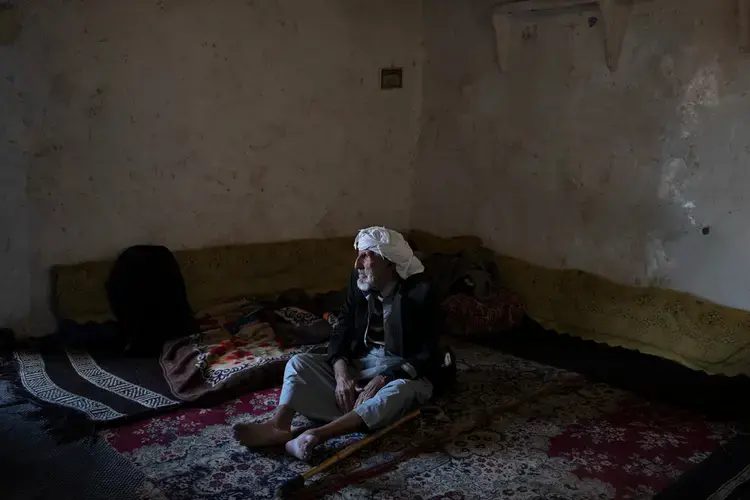
At a local union hall in Tucson, I met two funny, gentle, welcoming men, and we spoke for an evening about their lives at Raytheon. (I have elected not to identify them.) One of them, a quiet man with an easy, endearing laugh, worked in assembly, where all the pieces come together before a weapon goes out the door. His story of going to work at Raytheon sounded to me like the Platonic ideal of the American working family in the postwar industrial boom. His father had a good job at the plant, and he wanted to be just like his dad. He started out as a custodian, working his way up to his current position.
The other man, who had been a machinist for years, was proud of his work, too. He described at first a line of reasoning that politicians use too: that better precision-guided weapons help countries avoid hurting anyone they’re not trying to. For him, though, the thing that he said made him most proud about working at Raytheon was helping to keep American servicemen and women safe. The company makes a point of hiring veterans with combat injuries, which reminds him of whom he’s working for and why. He feels it when he sees the gigantic photos of service members that the company hangs in the most prominent parts of the plant. The photos, he explained, are of relatives of Raytheon workers. When he’s at work, the notion of helping American servicemen and women is not abstract. It’s almost tactile.
The company’s impact is considerably more abstract from the C-suite. On the most recent earnings call, an analyst asked Raytheon executives about the Saudi arms sales. His concern was whether “issues in the Middle East at the moment and specifically Saudi Arabia” could have “any negative ramifications for your business.” The answer was, in essence, Don’t worry. The company’s chief executive, Thomas Kennedy, reminded analysts that Raytheon has customers in over 80 countries. Raytheon’s chief financial officer, Anthony O’Brien, then chimed in to add that the Saudis accounted for just 5 percent of the company’s revenue.
About a year after the strike, the Joint Incident Assessment Team, a body composed of coalition members that analyzes the legality of its own airstrikes, released a statement saying that the pilots had bombed the well site in Arhab because they thought it was a ballistic-missile launcher. It’s an excuse that strains credulity; ballistic-missile launchers do not look very much like drilling rigs. On the other hand, Saudi pilots are known to prefer flying as high as they can for fear of ground fire, and that makes them more likely to misidentify what they’re bombing. And thanks to American aerial refueling, the Saudi jets could engage in “dynamic targeting,” meaning they go out and look for things to bomb.
It had been two years and a month since the strike by the time I made my way to Yemen, and then up to Arhab in rebel territory, after months of negotiations; I had to get permission from the Saudi-backed government in the south and from the Houthis in the north. I needed to fly into Saudi-controlled Aden and make my way by road to rebel territory. I was made to dress in traditional Yemeni clothes and chew khat in order to sneak through the checkpoints, though I’m not sure whether this was necessary for my own safety or for the amusement of my fixers. I arrived in the north to find other journalists who had simply gotten in cars in their safari shirts.
I had expected the scene of the attack to be sterilized by the time I arrived. But the bomb site still looked like a bomb site: bits of headlight housings, things that looked like spark plugs, curled pieces of rubber that I assumed had once been tires. There were craters a few feet from the well, then a few meters away another one, some a hundred meters away or more. People had run far. The tank from the water truck still lay smashed against a bank of rocks; it looked like a giant soda can shot through buckshot and then crushed by a giant hand. The chassis was still there too, twisted up on the rock. Both of them were too heavy, or too pointless, to move. Villagers kicked around the rocks, nudged pebbles aside with their shoes and handed little things to me that felt much heavier than they looked. These, they said, were from the bombs.
My first morning in Arhab I spent in a classroom with 30 or maybe 50 people, maybe 60. Many had obvious and horrifying injuries, while others were brandishing ID cards to show me. I didn’t at first understand, and then my translator started saying, “That’s his brother”; “That’s his son.” They had come anticipating that they would need proof. That the American might not believe they lost who they said they lost. I had never been in a room with so many grown men in tears.
I met Yousef, the drill worker, in that classroom. He looked sad, but I thought he was wrongly translated when he told me that he had lost a leg. He must have seen my confusion, because he hiked the fabric of his skirt up and showed the basic plastic prosthesis clipped to a stump, above where his knee would have been.
I met Fahd in that classroom, too. And after that, I spent a lot of time with him, mostly on the floor of a room in a village elder’s house. By then he had spent most of a year in the hospital, managing to evade deadly infection, then most of a year out of it, but he had changed. His arms were curled and contracted. He couldn’t lift much of anything, so he was mostly useless in the fields. He couldn’t provide for his family, and he had lost his entire investment that day at the well.
But what frustrated him most was the shrapnel the doctors couldn’t remove from his head. He told me it changes the way his mind works; he’s angry all the time, and he thinks there’s a chemical reason for that, something in the metal. Sometimes, he said, it hurts so badly that he has an urge to remove it and has to stop himself from grabbing a knife and cutting into his face. As Fahd was explaining to this, the room grew quiet. He stopped midconversation, and someone pointed up at the ceiling as if having a thought. “F-15s.”
They told me to go outside so I could hear better, to look up. I did, and I couldn’t see anything, but I could hear, just barely. I wouldn’t have identified it as a fighter jet. I’m not even sure I would have identified it as a plane. It sounded like a very concentrated wind, miles away. I asked how they knew it wasn’t a commercial flight, and they reminded me of the blockade: There are no commercial flights here. And anyway, the sound is different. Even children there knew the sound F-15s make. They had learned to tell the difference between the sonic signatures of the aircraft that fly overhead, making up names, onomatopoeia for the noises they make, like zanana and waziza, for the buzzing drones. The next day, I would learn of an airstrike in the neighboring district.
Back inside, we resumed our conversation, but again, Fahd stopped talking for a moment, and this time, he began moving across the carpet toward me. He hoisted himself over his bad leg and leaned forward. His eyes were suddenly bright, and I saw what other villagers had described when they spoke of Fahd before the strike, this once-energetic man, once so intense and charismatic.
He tilted his head toward me, and then I understood he wanted me to touch his face. I turned my wrist to use the back of my hand, as if checking a child for a temperature; somehow that seemed less intrusive. Fahd moved his head closer, and then my hand was against his face, and I could feel hard bits of metal rolling around beneath the cartilage of his jaw. He guided my hand up to his temple, where some misshapen thing slid around beneath the skin, as if trying to escape my fingers. He pulled his eyelid down to show where the steel still was. And it struck me that this was a surreal way to encounter American ordnance, at the end of journey that began in the American Southwest and brought it all the way here, in this remote part of a desperately poor country, to the face of a man who, for just a moment two years and one month ago, thought he had something to celebrate.
John Ismay contributed reporting for this article.
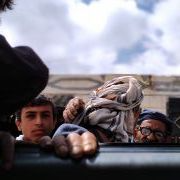
Education Resource
Meet the Journalist: Jeffrey Stern
Author and photographer Jeffrey E. Stern explains his approach to reporting on the world's worst...


